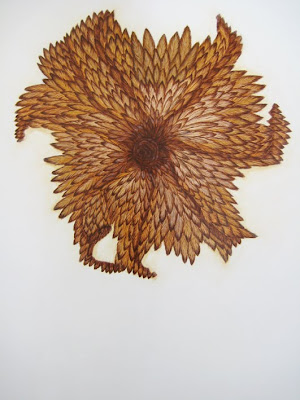
Friday, November 06, 2009
Thursday, November 05, 2009
Tuesday, July 14, 2009
GYAN MUDRA

GYAN MUDRA
The thumb and the index finger are brought together in gentle contact, not pressing hard, while all other fingers are kept upright. This is the mudra most people are familiar with.
Great thinkers such as Buddha, Mahavir, Christ and Guru Nanak are generally depicted in this pose. Its practice ensures mental peace, concentration, sharp memory and spiritual feelings.
It cures insomnia and mental disorders, and dissipates tension, depression and drowsiness. This is a must for those who aspire to develop telepathy or wish to acquire extrasensory abilities.
APAN VAYU MUDRA

APAN VAYU MUDRA
(Also known as Mritsanjeevini Mudra)
Fold the forefinger down and touch the mound of the thumb. The little finger should be held erect.
It regulates complications of the heart. In a severe heart attack, if administered as a first aid measure within the first two seconds, it provides instant relief.
PRAN MUDRA

PRAN MUDRA
Touch the points of the little finger and the ring finger to the tip of the thumb lightly.
This is a life-giving mudra, it energizes the body and improves its vitality.
It helps to improve eyesight. A must for those who feel nervous, tired and weak.
Hirschi, p70
This mudra is associated with the root chakra, in which the elemental force of a human being is found. I like to compare this place with a fire that iseither ablaze or just glows queietly. How brightly the fire burns depends on how well we tend it. This finger position stimulates thnourishin energy in the pelvic floor.
The mudra generally improves vitality, reduces fatigue and nervousness and improves vision. It is also used against eye diseases. On the mental emotional level it increase our staying power and assertiveness, healthy self confidence gives us the courage to start something new, and the strength to see things through. Clear eyes are also a sign of amental outlook emphasizing clarity and a clear mind, which means clearly structured thoughts and ideas.
According to Kim da Silva,when you do the Pran Jucra you can also put your thumb onto the fingernails of the other two fingers instead of their tips. This has the effect of causing both of the right and left brain hemispheres to function equally, become active, and mutually complement each other, which is very important for holistic health.
Nervousness is usually a sign of weakness, of too much distraction and too little inner stability. The mudra, combined with a conscious, slow and gently way of breathing- has the effect of being as stabilizing and calming as a secure anchor.
SURABHI MUDRA
APAN MUDRA

APAN MUDRA
Join the middle finger and the ring finger with the tip of the thumb; the forefinger and the little finger should be held upright.
Provides relief in urinary problems and eases difficulty in labor and delivery. It facilitates the discharge of waste matter from the body and purifies the syst
Hirschi, p74
This mudra supports the removal of waste materials and toxins from the body, as well as eliminatiing urinary problems, according to Keshav Dev.
This mudra also stimulates the wood element, which is associated with the energy of the liver and gallbladder. This element also contains the power and pleasure of springtime, of new beginnings of tackling and shaping visions for the future.
In addition, the Apan Mudra has a balancing effect on the mind, which is largely dependent upon a well functioning liver. It gives us patience, serenity, confidence, inner balance and harmony. In the mental realm, it creates the ability to develop vision. You need all of this when you look into the future, while facing new challenges and if your wishes are to be fullfilled.
LINGA MUDRA

LINGA MUDRA
Join both the palms and lock the facing fingers together, keeping one thumb upright. The upright thumb must be encircled by the other thumb and the index finger.
Makes the body resistant to colds, coughs and chest infections by generating heat in the body, and destroying accumulated phlegm in the chest.
It helps in weight reduction too, but has to be practiced with restraint.
The intake of at least eight glasses of water, and butter and ghee (clarified butter) as cooling agents in sufficient quantities is a must.
Due to the heat it generates, it may not be possible to practice this mudra with as much ease and flexibility as the other mudras. It might prove taxing and result in a feeling of lethargy.
SHUNYA MUDRA

SHUNYA MUDRA
Bring the middle finger down to touch the palm and bring the padding of the thumb on top of it, keeping the other fingers straight up.
Do this for 40 minutes a day.
This mudra is ideal for ailments of the ear, and also helps those of the nose and the throat.
Even five minutes of this mudra will help an earache.
VARUNA MUDRA
Tuesday, June 30, 2009
The Medicine Buddha (Bhaishajyaguru)
The Medicine Buddha (Bhaishajyaguru)
19th century
67.1999
Art Gallery of New South Wales
Maitreya (Buddha of the Future) 566.1996
Maitreya (Buddha of the Future)
Yuan dynasty 1279 - 1368/China
14th century
566.1996
Art Gallery of New South Wales
Buddha calling the earth to witness 83.1997
Buddha calling the earth to witness
late 12th century
83.1997
Art Gallery of New South Wales
Standing Buddha 428.1985
Standing Buddha
15th century
428.1985
Art Gallery of New South Wales
Figure of Buddha 85.1986
Swat Valley/Ancient Gandhara/Pakistan
Figure of Buddha
Kushan period mid 1st century - early 5th century/India
2nd century
85.1986
Art Gallery of New South Wales










































